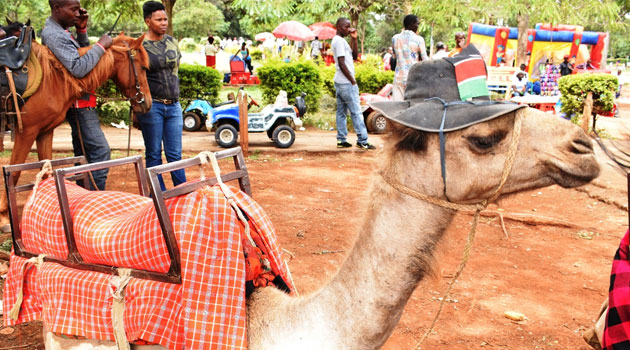
Amidst the pomp and colour, there was a caravan of camels, some with wounds that attracted flies. Some had teary faces even as their mouths tightly tied with ropes used to guide them/FILE
NAIROBI, Kenya, Jan 4 – On December 25, Uhuru Park was a beehive of activities as families flocked to celebrate Christmas Day.
Fathers held the hands of their children dressed in their best attires. Face painting was on top gear as children fought to face the brush first. The nearest amusement park was teeming with activities as children rode the train, adults watching from a distance, their faces drenched in happiness.
Amidst the pomp and colour, there was a caravan of camels, some with wounds that attracted flies. Some had teary faces even as their mouths tightly tied with ropes used to guide them. They occasionally made a grunt, perhaps in the hope that their handlers would feel their pain but it all fell on deaf ears.
The camels still had to carry overzealous children and adults whose enthusiasm for extracting fun from the poor beasts of burden couldn’t be dampened by the heart wrenching sound.
Mahatma Gandhi opined that the greatness of a nation can be judged by the way its animals are treated, and he was right. Cases of burnt, neglected, tortured, abused and starved animals are common in Kenya, especially in urban areas, a pointer to deteriorating level of humanity as profits become more important than welfare.
The abuse doesn’t stop there. In extreme cases, some human beings have been caught in the unnatural acts of making love to animals.
“Kenyans should see animals as beings that have feelings. Even cows and goats have feelings,” lamented a frustrated Dr Diana Onyango, the executive officer of the Kenya Society for the Protection and Care of Animals (KSPCA).
The trained veterinary doctor decried the lethargic attitude with which the animal rights cases are handled by the security officers.
Perhaps, when security forces shot dead over 300 cows in Laikipia in 2017, from that one instance of cruelty, removing all the politics that marred the incident and how Kenyans reacted, we can glean the attitude of security forces towards animals.
In Kenya, Parliament passed the Prevention of Cruelty to Animals Act (2012) which was a revised version of the earlier law passed in 1983.
But Kenya is a country famous for crafting excellent laws and policies but enforcement is often a tall order. That’s why scenes of camels with festering wounds in their bodies are hardly missed every time you meet a caravan.
“The laws are there but enforcement is a challenge due to ignorance of the law or the attitude of some law enforcers. We are not seeing a strong support from law enforcers,”
“Those who are taken to court can easily get themselves out because the punishment is very low (Sh3,000 fine or six months in jail or both) and can’t deter repeat offenders.”

Amidst the pomp and colour, there was a caravan of camels, some with wounds that attracted flies. Some had teary faces even as their mouths tightly tied with ropes used to guide them/FILE
The Constitution under the Fourth Schedule explains the roles of the two levels of government in promoting animal welfare, it is not clear whether enforcement is effective or not. The national government is responsible for the protection of wild animals in conservation areas while the county governments are mandated to seeing the welfare of domestic animals including livestock and pets.
But even excellent laws cannot mitigate bad culturally entrenched attitudes as is the case with animal welfare.
“We still have people who are not quite compassionate towards animals and they wonder why you would spend resources towards them because they don’t understand that they also have feelings,” she lamented.
If not for the younger generation of Kenyans who are embracing the culture of indoor pets, Dr Onyango’s verdict about the attitude of Kenyans would have been grimmer.
“People are becoming more compassionate to animals especially the younger people who are taking in dogs and cats as pets. I would put it at five because over the years it has improved,” she noted.
Animals have been used since time immemorial to add colour to human life. Even Jesus Christ of Nazareth as recorded in the Bible rode a donkey while entering Jerusalem. Animal products such as milk and meat by cows and goats are used to nourish man for sustenance. Dogs and cats provide companionship while donkeys and horses carry heavy loads.
Cases of malicious physical injury, neglect, starvation, manhandling during transportation, overloading, inhumane treatment at slaughter and inhumane methods of animal identification are some of the common forms of abuse.
“If an animal you own is sick, but you have it in the house without giving it a veterinary attention, you are distressing the animal.”
Recently, it’s become a normal scene to spot camels and horses in recreational facilities as Kenyans, especially children, take a ride on the animals. Also, in recent past, Kenyans have been treated to a rare show of painted donkeys during political rallies. Pigs too have been released outside Parliament with red paints on them to pass a message.
“Those people who misuse animals are in contravention of the law. The challenge is that some magistrates or law enforcers aren’t fully aware of the act and some aren’t fully compassionate towards animals.”
As it stands, KSPCA is banking on active advocacy efforts to shed light on the need to treat animals in a better way. Also, they are targeting children with the hope that the next generation of adults will be more compassionate towards animals. In the meantime, their emergency lines are open as their field officers respond to the numerous cases reported of abuse of animals.









































